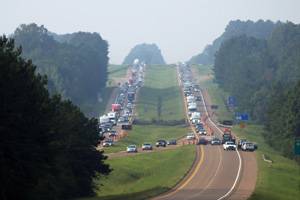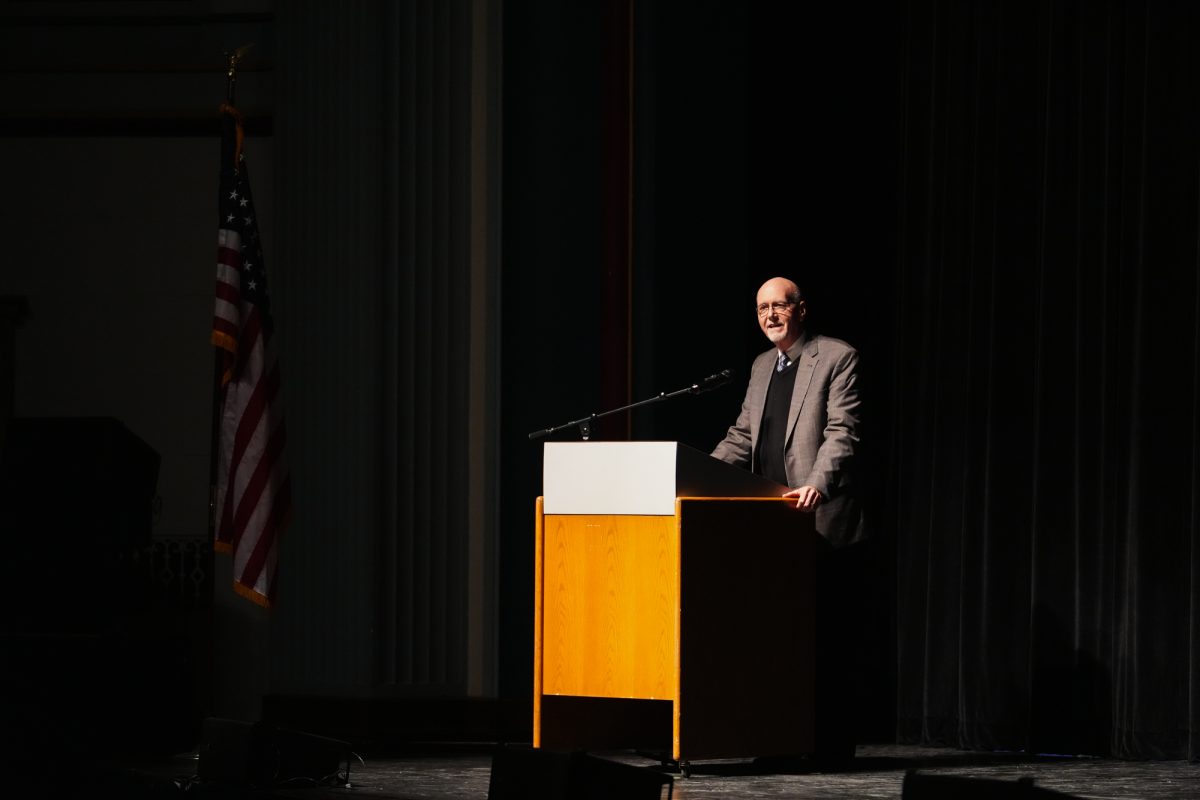As Gustav nears, New Orleans becomes a ghost town

Contraflow traffic from the southbound lane on U.S. 55 is re-routed into the northbound lane just north Exit 30 at Bogue Chitto, Miss., on Sunday, Aug. 31, 2008. The interstate was contraflowed in order to allow a quicker and more organized evacuation from areas expected to be hit the hardest by Hurricane Gustav. (AP Photo/Therese Apel, The Daily Leader)
August 31, 2008
NEW ORLEANS – With Hurricane Gustav just a day away from a possible monster hit on New Orleans, the mayor Sunday pleaded with the last of its residents to get out, imposed a dusk-to-dawn curfew on those who stay and warned looters they will be sent directly to prison.
The Big Easy increasingly took on the eeriness of a ghost town as thousands heeded a mandatory evacuation order, and police and National Guard troops clamped down on the city to prevent the kind of lawlessness and chaos that followed Katrina three years ago.
“Looters will go directly to jail. You will not get a pass this time,” Mayor Ray Nagin said. “You will not have a temporary stay in the city. You will go directly to the Big House.”
Most were taking him seriously. The state changed traffic flow so all highway lanes led out of New Orleans, and cars were packed bumper-to-bumper. Stores and restaurants shut down, hotels closed and windows were boarded up. Some who planned to stay changed their mind at the last second, not willing to risk the worst.
“I got scared at the last minute,” said Ollie Hilson, 54, of Marrero, a town on the west bank of the Mississippi River. She was waiting for a bus in a gymnasium where the New Orleans Hornets practice. She had a single plastic grocery bag with a change of clothes and a few personal belongings, and waited with her two nieces and their four children, all under the age of 3. “I was worried about the kids. We just couldn’t stay.”
Col. Mike Edmondson, state police commander, said he believed over 90 percent of the coastal Louisiana population had fled — the largest evacuation in state history.
Nagin has used stark language to get his message across to residents, calling Gustav the “mother of all storms.” Emergency officials have repeatedly warned that those who stay are on their own, and there will be no shelter of refuge like in Katrina, when thousands waited helplessly for rescue in a squalid Superdome.
Though his threats were dire, it was unmistakable that Gustav posed a major threat to partially rebuilt New Orleans. The storm has already killed more than 80 people on its path through the Caribbean. And there are fears about how much the levees, which breached during Katrina, can take.
Large areas of southeast Louisiana, including sections in the greater New Orleans area, that are protected by levees face being flooding by several feet of water, according to Gustav surge models. Gustav appears likely to overwhelm the system of levees west of the city that have for decades been under-funded and neglected even as the population has grown.
The Army Corps of Engineers has stockpiled steel pilings, sandbags and metal baskets filled with sand in the event that emergency repairs are needed to fill in breaches. Heavy duty helicopters capable of dropping sandbags are on standby.
Barreling toward the Gulf Coast with frightening strength and size, Gustav was wavering between a Category 3 and 4 hurricane with winds extending out 50 miles and tropical storm force winds as far as 200 miles. The comparisons to Katrina come easily.
Both are extraordinarily large storms. At times Katrina, one of the five deadliest U.S. storms, stretched its tropical storm-force winds out about 200 miles from its center. Hurricane force winds extended about 90 miles.
Both Gustav and Katrina intensified rapidly in the Gulf of Mexico, but Katrina intensified after making landfall in Florida while Gustav hit Cuba first. Forecasters say Gustav also is moving more quickly than Katrina.
President Bush canceled his appearance at the Republican National Convention and will instead travel to Texas to meet with emergency response personnel preparing for Gustav. Federal authorities, faulted for a sluggish and inadequate response to Hurricane Katrina, planned to have an on-the-ground presence. Homeland Security Secretary Michael Chertoff arrived in the region Sunday and planned to stay for the duration of the storm.
Chertoff stopped at an evacuation center in Houma as the last few people got on buses for Shreveport and Dallas. He said he was happy to see an almost 100 percent evacuation, and stepped onto two of the buses to wish the passengers well. “You made the right choice getting on this bus,” he said.
Bush said he hoped to travel to Louisiana when conditions permit.
“The Army Corps of Engineers informs me that while the levees are stronger than they’ve ever been, people across the Gulf Coast, especially in New Orleans, need to understand that in a storm of this size there are serious risks of significant flooding,” Bush said at FEMA headquarters. “My message to the people of the Gulf Coast is: This storm is dangerous.”
The storm could bring a storm surge of up to 20 feet to the coast and rainfall totals of up to 15 inches.
At 2 p.m. EDT Sunday, the National Hurricane Center said Gustav was a Category 3 storm centered about 270 miles southeast of the mouth of the Mississippi River and moving northwest near 17 mph. It had top sustained winds of around 115 mph. It had weakened slightly, but forecasters expected some reintensification by Monday.
A hurricane warning was in effect for more than 500 miles of the Gulf Coast from Cameron, La., near the Texas border to the Alabama-Florida state line. Alabama Gov. Bob Riley issued a mandatory evacuation order for some coastal areas of Mobile and Baldwin counties.
Residents in flood-prone southeast Texas fled, too. Sabine Pass a port city most recently battered three years ago by Hurricane Rita, was among the first communities ordered to leave. Port Arthur, Texas, a refinery town of about 57,000 also badly damaged during Rita, was virtually abandoned.
In New Orleans, the last bus carrying residents without a way to leave on their own would depart at 3 p.m. Sunday. Clouds were already rolling in, and the skies were beginning to darken. Rain could begin falling as early as Sunday night.
Melissa Lee, who lives in Pearl River, a town near the boundary of Mississippi and Louisiana, was driving away to as far as she could make it Sunday. Before she left, she heard neighbors chopping down trees with chain saws, trying to ensure the tall pines that surrounded their homes wouldn’t come crashing down.
“I sent my son out with a camera and said, ‘Go take pictures of our backyard. Because it’s going to look different when we get back.'”
– Associated Press writers Janet McConnaughey, Cain Burdeau, Alan Sayre, Allen G. Breed, Mary Foster and Stacey Plaisance contributed to this report from New Orleans. Vicki Smith in Houma, Doug Simpson in Baton Rouge and Michael Kunzelman in Lafayette also contributed. Kelli Kennedy reported from Miami.





